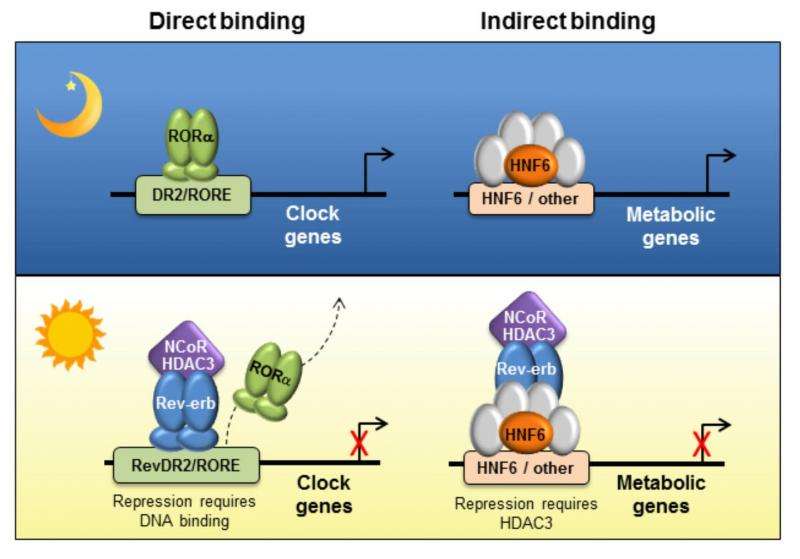Protein maintains double duty as key cog in body clock and metabolic control

Around-the-clock rhythms guide nearly all physiological processes in animals and plants. Each cell in the body contains special proteins that act on one another in interlocking feedback loops to generate near-24 hour oscillations called circadian rhythms. These dictate behaviors controlled by the brain, such as sleeping and eating, as well as metabolic, hormonal, and other rhythms that are intrinsic to the organs of the body. For example, when you eat may have affects on rhythms controlling fat or sugar metabolism, illustrating how circadian and metabolic physiology are intricately intertwined.
Rev-erbα is a transcription factor (TF) that regulates a cell's internal clock and metabolic genes and has been the focus of the lab of Mitchell Lazar, MD, PhD, director of the Institute for Diabetes, Obesity, and Metabolism at the Perelman School of Medicine at the University of Pennsylvania, for more than two decades. Now, in a new study published online ahead of print in Science Express, the Lazar team describes how Rev-erbα regulates the clock in most cells in the body and metabolic genes in the liver, the body's key organ for metabolism of fat as well as sugar. "The exciting new finding is that, rather than use the same mechanism for regulating both the liver's clock and metabolic function, Rev-erbα does these jobs in distinct ways," Lazar explains.
Knowing the exact molecular players and the differences in these two important and related roles for Rev-erbα is helping scientists better understand and develop drugs for such disorders as diabetes, metabolic disorders in shift workers, and potentially even others.
"We showed that Rev-erbα modulates the clock and metabolism using different mechanisms of interacting with a cell's genome," notes Lazar of Rev-erbα's double duty. "On one hand, clock control requires Rev-erbα to bind directly to the genome, where it competes with other transcription factors, for repression of clock genes during the day."
On the other, Rev-erbα regulates metabolic genes in the liver at places in the genome where it is instructed to bind by other liver-specific factors. This indirect type of control by Rev-erbα is unique to the liver, yet is coupled to the clock since levels of Rev-erbα itself are circadian, meaning that it's only expressed at high levels in the liver at certain times of day.
The metabolic effects of Rev-erbα include a major role in the regulation of liver fat. Fatty liver has become a huge societal problem, and if untreated, can lead to liver inflammation (hepatitis) and life-threatening liver failure (cirrhosis). Fatty liver is highly related to obesity and diabetes, which are also major public health threats in the US and throughout the world.
"It is critical to find new ways to prevent or reverse the accumulation of fat in the liver," Lazar says. "Previously it was difficult to imagine how Rev-erbα could be a drug target for fatty liver if it was also involved in the maintaining the body's clock that controls sleep."
The Penn team's new findings show that the role of Rev-erbα in self-sustained control of the molecular clock across all tissues is different from that in the liver. "These two distinct modes of action may give Rev-erbα the ability to stabilize the circadian oscillations of clock genes, while coupling liver metabolism to daily environmental and metabolic changes," Lazar says. The coupling may occur through metabolites such as heme, the body's oxygen-carrying molecule, and other proteins, including an enzyme called histone deacetylase (HDAC), which are more critical for Rev-erbα's metabolic function than its role in the clock.
"This raises the possibility that drugs that specifically affect Rev-erbα's interaction with metabolites or the HDAC enzyme, without disrupting the clock throughout the body could modulate liver metabolism while minimizing effects on the overall integrity of the circadian clock," he says. HDAC inhibitors are already in the clinic for certain forms of cancer. The researchers' hope is that this next chapter in Rev-erbα research can provide a new and more specific way to combat the growing epidemic of metabolic disease, especially fatty liver.
More information: Discrete functions of nuclear receptor Rev-erbα couple metabolism to the clock, Science Express, www.sciencemag.org/lookup/doi/ … 1126/science.aab3021

















